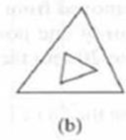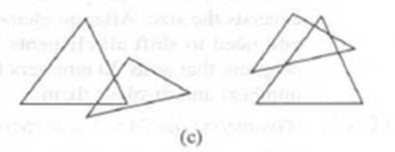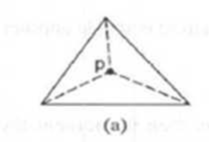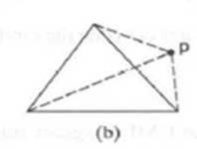
(Geometry: the Triangle2D class) Define the Triangle2D class that contains:
- Three points named p1, p2, and p3 of the type MyPoint with getter and setter methods. MyPoint is defined in
Programming Exercise 10.4. - A no-arg constructor that creates a default triangle with the points (0, 0), (1,1), and (2,5).
- A constructor that creates a triangle with the specified points.
- A method getArea () that returns the area of the triangle.
- A method getPerimeter () that returns the perimeter of the triangle.
- A method contains (MyPoint p) that returns true if the specified point p is inside this triangle (see Figure 10.22a).
- A method contains(Triang1e2D t) that returns true if the specified triangle is inside this triangle (see Figure 10.22b).
- A method overlaps(Triangle2D t) that returns true if the specified triangle overlaps with this triangle (see Figure 10.22c).



FIGURE 10.22 (a) A point is inside the triangle, (b) A triangle is inside another triangle. (c) A triangle overlaps another triangle.
Draw the UML diagram for the class and then implement the class. Write a test program that creates a Triangle2D object t1 using the constructor new Triangle2D(new MyPoint(2.5, 2), new MyPoint(4.2, 3), new MyPoint(5, 3.5)), displays its area and perimeter, and displays the result of t1.contains(3, 3), r1.contains(new Triangle2D(new MyPoint(2.9, 2), new MyPoint(4, 1). MyPoint(1, 3.4))).and t1 .overlaps(new Triangle2D(new MyPoint(2, 5.5), new MyPoint (4. –3), MyPoint(2, 6.5))).
(Hint: For the formula to compute the area of a triangle, sec Programming Exercise 2. 19. To detect whether a point is inside a triangle, draw three dashed lines, as shown in Figure 10.23. If the point is inside a triangle, each dashed line should intersect a side only once. If a dashed line intersects a side twice, then the point must be outside the triangle. For the


FIGURE 10.23 (a) A point is inside the triangle, (b) A point is outside the triangle.
Trending nowThis is a popular solution!

Chapter 10 Solutions
Introduction to Java Programming and Data Structures, Comprehensive Version (11th Edition)
Additional Engineering Textbook Solutions
Starting Out with C++: Early Objects (9th Edition)
Starting Out With Visual Basic (8th Edition)
Introduction To Programming Using Visual Basic (11th Edition)
Starting Out with Java: From Control Structures through Objects (7th Edition) (What's New in Computer Science)
SURVEY OF OPERATING SYSTEMS
Starting Out with Java: From Control Structures through Data Structures (4th Edition) (What's New in Computer Science)
- Please show the code for the Tikz figure of the complex plane and the curve C. Also, mark all singularities of the integrand.arrow_forward11. Go to the Webinars worksheet. DeShawn wants to determine the number of webinars the company can hold on Tuesdays and Thursdays to make the highest weekly profit without interfering with consultations, which are also scheduled for Tuesdays and Thursdays and use the same resources. Use Solver to find this information as follows: a. Use Total weekly profit as the objective cell in the Solver model, with the goal of determining the maximum value for that cell. b. Use the number of Tuesday and Thursday sessions for the five programs as the changing variable cells. c. Determine and enter the constraints based on the information provided in Table 3. d. Use Simplex LP as the solving method to find a global optimal solution. e. Save the Solver model below the Maximum weekly profit model label. f. Solve the model, keeping the Solver solution. Table 3: Solver Constraints Constraint Cell or Range Each webinar is scheduled at least once on Tuesday and once on Thursday B4:F5 Each Tuesday and…arrow_forwardGo to the Webinars DeShawn wants to determine the number of webinars the company can hold on Tuesdays and Thursdays to make the highest weekly profit without interfering with consultations, which are also scheduled for Tuesdays and Thursdays and use the same resources. Use Solver to find this information as follows: Use Total weekly profit as the objective cell in the Solver model, with the goal of determining the maximum value for that cell. Use the number of Tuesday and Thursday sessions for the five programs as the changing variable cells. Determine and enter the constraints based on the information provided in Table 3. Use Simplex LP as the solving method to find a global optimal solution. Save the Solver model below the Maximum weekly profit model label. Solve the model, keeping the Solver solution. Table 3: Solver Constraints Constraint Cell or Range Each webinar is scheduled at least once on Tuesday and once on Thursday B4:F5 Each Tuesday and Thursday…arrow_forward
- I want to ask someone who has experiences in writing physics based simulation software. For context I am building a game engine, and want to implement physics simulation. There are a few approaches that I managed to find, but would like to know what are other approaches to doing physics simulation entry points from scenes, would you be able to visually draw me a few approaches (like 3 approaces)? When I say entry point to the actual physics simulation. An example of this is when the user presses the play button in the editor, it starts and initiates the physics system. Applying all of the global physics settings parameters that gets applied to that scene. Here is the use-case, I am looking for. If you have two scenes, and select scene 1. You press the play button. The physics simulation starts. When that physics simulation starts, you are also having to update the physics through some physics dedicated delta time because physics needs to happen faster update frequency. To elaborate,…arrow_forwardI want to ask someone who has experiences in writing physics based simulation software. For context I am building a game engine, and want to implement physics simulation. There are a few approaches that I managed to find, but would like to know what are other approaches to doing physics simulation entry points from scenes, would you be able to visually draw me a few approaches (like 3 approaces)?When I say entry point to the actual physics simulation. An example of this is when the user presses the play button in the editor, it starts and initiates the physics system. Applying all of the global physics settings parameters that gets applied to that scene.Here is the use-case, I am looking for. If you have two scenes, and select scene 1. You press the play button. The physics simulation starts. When that physics simulation starts, you are also having to update the physics through some physics dedicated delta time because physics needs to happen faster update frequency.To elaborate, what…arrow_forwardMale comedians were typically the main/dominant star of television sitcoms made during the FCC licensing freeze. Question 19 options: True False In the episode of The Honeymooners that you watched this week, why did Alice decide to get a job outside of the home? Question 1 options: to earn enough money to buy a mink coat to have something to do while the kids were at school to pay the bills after her husband got laid offarrow_forward
- After the FCC licensing freeze was lifted, sitcoms featuring urban settings and working class characters became far less common. Question 14 options: True Falsearrow_forwardsolve this questions for me .arrow_forwarda) first player is the minimizing player. What move should be chosen?b) What nodes would not need to be examined using the alpha-beta pruning procedure?arrow_forward
- Consider the problem of finding a path in the grid shown below from the position S to theposition G. The agent can move on the grid horizontally and vertically, one square at atime (each step has a cost of one). No step may be made into a forbidden crossed area. Inthe case of ties, break it using up, left, right, and down.(a) Draw the search tree in a greedy search. Manhattan distance should be used as theheuristic function. That is, h(n) for any node n is the Manhattan distance from nto G. The Manhattan distance between two points is the distance in the x-directionplus the distance in the y-direction. It corresponds to the distance traveled along citystreets arranged in a grid. For example, the Manhattan distance between G and S is4. What is the path that is found by the greedy search?(b) Draw the search tree in an A∗search. Manhattan distance should be used as thearrow_forwardwhats for dinner? pleasearrow_forwardConsider the follow program that prints a page number on the left or right side of a page. Define and use a new function, isEven, that returns a Boolean to make the condition in the if statement easier to understand. ef main() : page = int(input("Enter page number: ")) if page % 2 == 0 : print(page) else : print("%60d" % page) main()arrow_forward
 C++ Programming: From Problem Analysis to Program...Computer ScienceISBN:9781337102087Author:D. S. MalikPublisher:Cengage Learning
C++ Programming: From Problem Analysis to Program...Computer ScienceISBN:9781337102087Author:D. S. MalikPublisher:Cengage Learning EBK JAVA PROGRAMMINGComputer ScienceISBN:9781337671385Author:FARRELLPublisher:CENGAGE LEARNING - CONSIGNMENT
EBK JAVA PROGRAMMINGComputer ScienceISBN:9781337671385Author:FARRELLPublisher:CENGAGE LEARNING - CONSIGNMENT Microsoft Visual C#Computer ScienceISBN:9781337102100Author:Joyce, Farrell.Publisher:Cengage Learning,
Microsoft Visual C#Computer ScienceISBN:9781337102100Author:Joyce, Farrell.Publisher:Cengage Learning,- Programming Logic & Design ComprehensiveComputer ScienceISBN:9781337669405Author:FARRELLPublisher:Cengage
 C++ for Engineers and ScientistsComputer ScienceISBN:9781133187844Author:Bronson, Gary J.Publisher:Course Technology Ptr
C++ for Engineers and ScientistsComputer ScienceISBN:9781133187844Author:Bronson, Gary J.Publisher:Course Technology Ptr New Perspectives on HTML5, CSS3, and JavaScriptComputer ScienceISBN:9781305503922Author:Patrick M. CareyPublisher:Cengage Learning
New Perspectives on HTML5, CSS3, and JavaScriptComputer ScienceISBN:9781305503922Author:Patrick M. CareyPublisher:Cengage Learning





